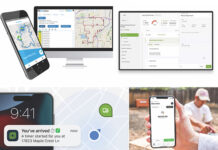To grow your business, you need the right equipment. Maybe it’s a new mower, a skid steer, or plow. While the need for new equipment is a good problem to have, it also comes with a few questions. Some of the common ones we hear from landscape business owners include: Should I buy or lease? How much should I invest in new equipment? What will my rate of return be on either option to maximize my profits?

The Real Cost
No matter where you are in your business growth, you must look at what you have today and where you’re hoping to go tomorrow. Consider things like:
- Can my current equipment do the job?
- Would additional equipment drive business growth?
- Is there technology available to improve operational efficiency?
Thinking through these factors, an inventory of your assets, and an overall budgeting plan will help determine your best path forward.
Here’s a real world example: Say you’ve got a three-person crew doing residential landscape construction. The industry average daily production is somewhere between $2,000 – $3,000 in revenue, per day—or about $100 in revenue per man, per hour.
One way you can improve the revenue generated without expanding crew is to provide them with the most productive equipment. A skid steer is a great example. Whether it’s loading/unloading a trailer, moving materials, or digging, a skid steer is a multi-use investment that could feasibly save time every day.
Let’s say the skid steer costs $850 per month, which to most businesses is significant. But it’s not as steep as you might think if you consider that any hour saved by using the equipment is an hour that can be used to generate revenue on the next job. For instance, if the machine will save half a day on a one week job, you’ve just opened that time to generate revenue somewhere else. If you can do that even once a month—that skid steer will pay for itself. If you can save a half-day for a 3-person crew, that means 12 additional man hours for revenue generating work—about $1,200 worth of opportunity. That could cover the monthly cost of the skid steer, maintenance, fuel, and insurance.
But what if a skid steer could help your crew save two days a month, representing about $4,000 of additional revenue, or about $36,000 per year—without needing to hire more people?
Buy, Lease, Or Use Old?
Many contractors struggle with the decision to invest in new equipment or keep older machinery. It’s a well worn dynamic. Older machines may have no payments but potentially high repair costs. Buying or leasing means you’re on the hook for a monthly payment, and the equipment depreciates the moment you have it at your jobsite, but you can expect to save on repairs, maintenance, and in some cases, fuel. While every company is different in the equipment they buy, how well they maintain it, and how hard they use it, generally speaking, most of the time, the monthly payments vs. fuel and maintenance savings are very similar—almost cancelling each other out.
The true cost of owning older equipment isn’t so much the obvious expense of repairs, but the more hidden cost of downtime. When a machine breaks down, the most significant cost is often the productivity lost. The cost of lost revenue potential is far greater than most owners realize. Remember: The potential revenue of each man hour is $100 per man, per hour. Just an extra half day of working and you’ve lost hundreds, or even thousands, in opportunity to generate revenue.
So while it may be tempting to forgo monthly payments, we’ve found many companies running newer equipment generate more revenue with less people and overhead. This often leads to a healthier bottom line—even if their equipment expenses are higher than average.
Benchmarking Decisions
Since every business is different, how do you make the decision to buy or lease vs. maintain and repair? Luckily, there is a benchmark to help. As a rule of thumb, if your repair and maintenance expenses are more than 1.5 times your fuel expenses, there’s a very good chance your equipment is costing more in repairs and downtime than you’d spend on interest or ownership costs of new equipment.
Landscape Management Network (LMN), an industry software provider, has developed an online calculator to help businesses calculate the lifetime value of machinery. It inputs a number of factors that go into any investment decision. It’s important to realize that your investment is more than just the sticker price. Here’s a rundown:
- First, the calculator looks at the equipment purchase price, life expectancy, and resale value. These numbers help owners understand how long they’ll have an asset, and if they were to sell it (once it’s paid off) what their return would be.
- Next, it asks what amount of money you’re able to put down. (Ideally you need at least 20%, but the more you have, the lower your interest rate.)
- Then the calculator asks the length of the loan, and the annual interest rate. This helps provide a total acquisition cost, or how much it will take over the loan lifetime to buy the equipment.
- Now the calculator asks questions about fuel, repair, and insurance costs per year, giving you a total lifetime operating costs.
- Finally, you need to estimate how much work you’ll need to do each year to calculate the cost per billable hour.
In just a few steps with common data, you can determine the lifetime and average annual equipment cost. Once you know those numbers, you can make a more informed decision on what to charge for that equipment and it’s total earning potential. To access the calculator, go to golmn.com.
Lease vs. Own
Once you’ve decided to get new equipment, you’re faced with another age-old question: lease vs. own. We’ve found that most contractors like to “own” their equipment (no payments) because it feels more risk-averse. However, many don’t realize this can stunt business growth potential and productivity.
Many companies wait until tax season or when they’ve saved up enough money to buy equipment. Yet had they leased, they could have potentially been driving productivity and revenue for months or even years before. With today’s interest rates, it can make sense for owners to pay the lease interest and keep their capital working for them in other ways—such as advertising, shop improvements, and more.
Interest Rates & Loan Options
If you go with a loan, it’s obviously important to understand interest rates. Every dealer, bank, or credit union will offer some sort of financing. Each option is great, but requires time. Also keep in mind that the more you have a credit application pulled, the more it impacts your credit score.
It’s also worth noting the differences between consumer versus commercial lending. Since commercial loans are used by companies to grow their businesses, they vary by type, features, functions, and benefits, whereas a consumer loan has less variables. Commercial loans are more complex, so be sure to turn to a trusted partner.
Making the decision to add equipment is a big one. It can increase productivity and help drive more work and revenue, but it comes at a cost. Understand your options and how it can help fuel your company. You’re in this business to grow. Bet on yourself, and think about impacts if you choose not to invest. You might be surprised.
 Schaubel is LMN’s Senior Vice President of Lending. He joined the company in September 2021 to lead the software platform’s lending business, including LMN Lend. He has more than 25 years of sales, marketing, and leadership experience across the landscape and construction industries. He brings a track record of helping companies grow and solving challenges for contractors including RodRadar, Powell Foundations, and Toromont Cat.
Schaubel is LMN’s Senior Vice President of Lending. He joined the company in September 2021 to lead the software platform’s lending business, including LMN Lend. He has more than 25 years of sales, marketing, and leadership experience across the landscape and construction industries. He brings a track record of helping companies grow and solving challenges for contractors including RodRadar, Powell Foundations, and Toromont Cat.
LMN has introduced LMN Lend, a new platform that helps business owners gain access to capital quickly through an online application. Contractors must meet criteria including: monthly revenue of at least $10,000; be in business for at least six months; and have a credit score of at least 550. A simple application process then sends the loan request to more than 200 financial institutions across North America for bids. Once bids are received, a lending specialist will help you find the right solution.











![[VIDEO] Dickies®: Discover Workwear That’s Anything But Uniform](https://turfmagazine.com/wp-content/uploads/2023/06/1647663814-4b1a2a7742790a9b1e97a3b963477850192e1d6a9dfba9b07214a77bae25d6e3-d-218x150.jpg)






























![[VIDEO] Dickies®: Discover Workwear That’s Anything But Uniform](https://turfmagazine.com/wp-content/uploads/2023/06/1647663814-4b1a2a7742790a9b1e97a3b963477850192e1d6a9dfba9b07214a77bae25d6e3-d-324x160.jpg)